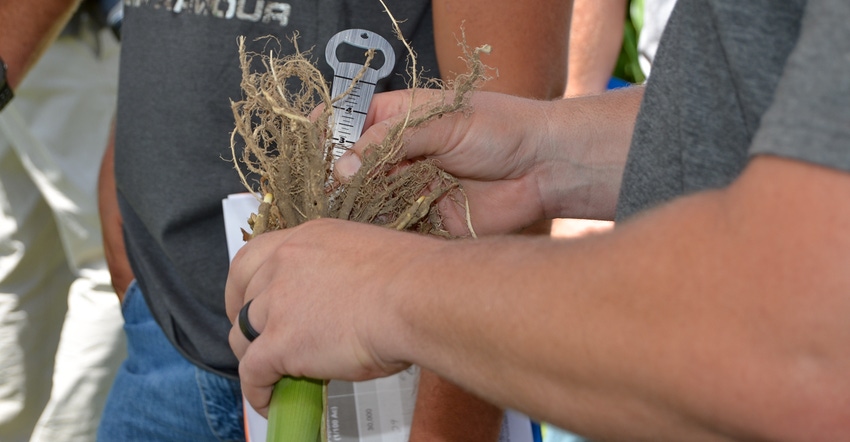
It has been a tough growing season for farmers and agriculture companies alike. While farmers are looking to fields for yield, companies like Syngenta are looking at plots for information. Both struggled as the lack of moisture in Missouri this year created problems with chemical activation and seed germination.
At one point in early May, Syngenta agronomic service representative Brett Craigmyle was using a water hose, trying to provide moisture to activate chemicals to the company trials in Boone County, Mo. Corn and soybeans were planted April 27 at the Grow More Experience site just south of Columbia, Mo., on Terry and Jerry Barnes’ farm. Craigmyle says planting conditions were good, the ground was starting to dry and the cool weather was turning warmer.

ROOT MASS: Famers measure corn roots during a stop at the Syngenta Grow More Experience field day. They looked at Golden Harvest hybrids planted at varied depths and then measured their root development. Shallow depths of less than 2 inches had less root mass.

Corn was planted at 30,000 population at a 2-inch depth, while soybeans were planted 145,000 seeds to the acre at a 1½-inch depth. The plants started to emerge; however, the rain did not fall. “We did not get a rain event for over 10 days after both the corn and beans were planted and herbicide sprayed,” Craigmyle says. But the 0.8 inch that did finally fall was enough to help the chemicals already put down to activate.
Actually, Craigmyle stopped talking of spraying the next overlapping residual days after planting, and he started using phrases like “after activation.” “I am going after rain events now when it comes to herbicide application timing,” he adds.
The site saw just one large rain event of 1.8 inches in mid-May. Up until June 20, the site received 5 inches total rainfall.
Still, the scenario is providing a learning experience for farmers. At the Grow More Experience site, sponsored by Golden Harvest, farmers walked the field looking at how corn and soybeans responded to cover crops, planting depth, insecticide and weed pressure in this less-than-ideal growing season.
Challenging cover
Farmers were quick to point out the yellowing corn in the cover crop plot. Golden Harvest agronomist Scott Gard says lack of moisture was the culprit.
Since an anhydrous bar could not run over the small plot area, Gard applied 200 pounds of urea at V5. “But we did not have any rain to get it into the soil profile,” he says. The result was nitrogen deficiency in the corn showing up in late June.
The cover crop residue ties up nitrogen. Gard says that farmers must realize cover crops compete with corn for nitrogen — so in dry years, the corn crop will need more. He suggests sidedressing.
Getting it in the ground
It is not so much of placing the corn seed in the ground as it is putting it in the right place. Planting depth matters during any year, but especially a drought year.
Soil moisture and temperature are better at 2 inches, according to Abbi Hawkins, Golden Harvest sales representative. This depth provides roots an opportunity to grow in ideal conditions. She says farmers should shoot for that planting depth with corn in any given year.
Hawkins says shallow planting depths are a “bad idea,” leading to uneven stands. At less than 2 inches, young corn plants emerge at different times. Ultimately, the Grow More Experience plot showed these shallow plants didn’t completely emerge until after all the corn planted at 2 inches. “The deeper planting depth provided more moisture and temperature stability for the plant,” Hawkins adds.
Creating more canopy
Soybeans also saw effects from low moisture, with some struggling to fill in rows. But one thing the Grow More Experience plot showed was that those treated with an insecticide saw a canopy advantage.
Clay Koenig, Syngenta seed care specialist, says that seed treated with Syngenta’s Cruiser provided the vigor the soybeans need to start strong. “With Cruiser, we saw a taller plant with more leaf structure and faster row canopy,” he says. How much more? About 15% more than those untreated soybeans.
Koenig explains how the larger leaf structure provides more light absorption and more cells for photosynthesis, allowing for greater nutrient and water uptake — something farmers desperately need in times of drought.
Weeding out yield-robbers
Why invest money to kill weeds? They are stealing your water.
According to Craigmyle, it takes roughly 9,703 cubic inches of water to produce 1 pound of dry matter in corn. But weeds like giant ragweed compete in your cornfields for every last drop.
Giant ragweed uses almost three times as much water — 27,000 cubic inches — to produce 1 pound of dry matter. And while the water is being diverted from the corn plant to the weed, it is adding insult to injury, as the weed uses the moisture to produce more seed to compete for water again next season.
While giant ragweed is mild at 3,500 seeds per plant, other problematic weeds like waterhemp can produce 250,000-plus seeds per plant.
Craigmyle does not suggest cutting back on your weed control program as a cost-saving measure in any year. He says weeds can alter corn growth and rob your corn plants of water, nitrogen, sunlight, and — ultimately — yield.
Farmers can visit Grow More Experience plots to learn more about Syngenta and Golden Harvest research. The plots provide information, training and customer experience with products.
About the Author(s)
You May Also Like






